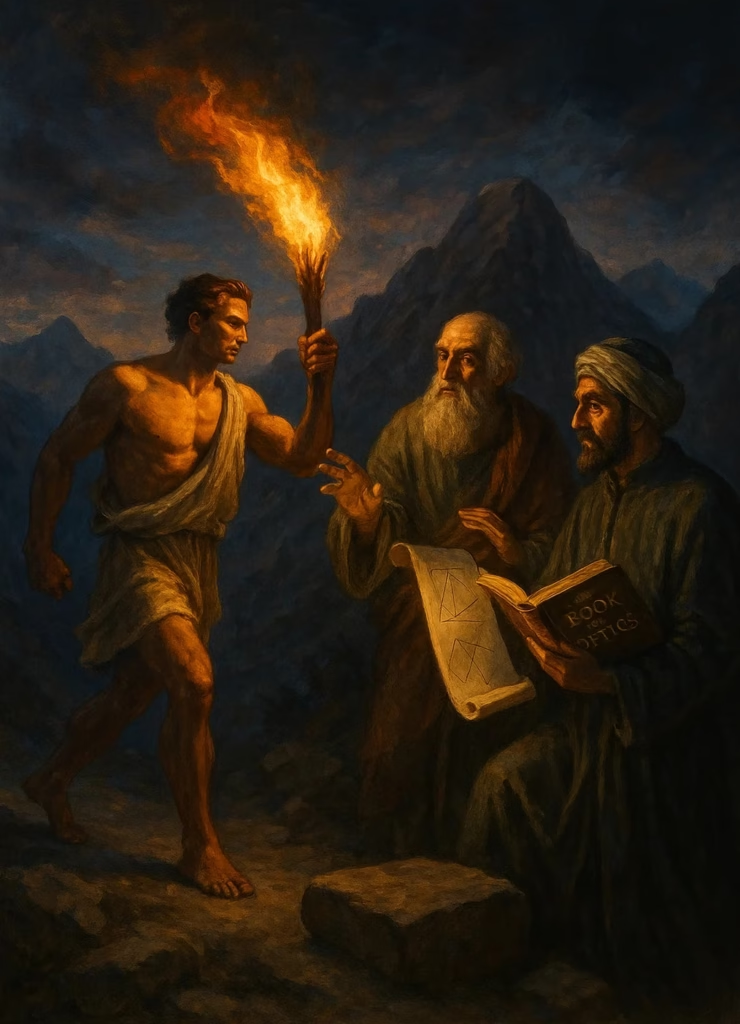Introductory Post: In the beginning was the word… and light
“Let there be light” – arguably the most famous words ever written. Spoken in the first sequence of the Book of Genesis, they are deeply etched into our collective unconscious, a symbol of every beginning, every breakthrough from the darkness of ignorance into knowledge and inspiration. According to these ancient texts, light was brought forth to separate chaos and void, to create order and enable life.
The paradox of our time lies in the fact that despite this millennial-long connection, we still do not know what light is. We can describe it. We can use it. Our entire modern technology rests upon it – from optical fibers to lasers, from telescopes to smartphones. Over 80% of the information about the world around us reaches us precisely through light. And yet, its ultimate explanation eludes us. It remains the greatest, and perhaps the oldest, mystery in the history of science.
Genesis: Two Stories About One Beginning 💡
The question of the world’s origin is central to both religion and science. While the Bible offers the powerful poetic force of divine creation, modern cosmology tells its own, equally astounding, story – the story of the Big Bang.
In this scientific cosmogony, everything began from a point of unimaginable density. After an expansion faster than light itself, the young universe found itself in a state of incandescent, opaque plasma, where light and matter were inextricably intertwined. Only after it had cooled and rarefied sufficiently did the universe become transparent. For the first time, light could begin its journey through space and time.
The glow of that first dawn, of that cosmic birth, we can still detect today. It is the Cosmic Microwave Background radiation – the “cooled” afterglow of the Big Bang, which fills every corner of the universe and brings us the most ancient message of all: the story of the very origin of everything.
The Beginnings of Optics: From Fire to the First Equations 🔥
Humans made light their own at the very dawn of civilization. The discovery of fire was not merely a practical matter; it was the first victory over darkness, the first step towards Prometheus’s future sin. In the Greek myth, Prometheus stole fire from the gods and gave it to humans, for which he paid a heavy price. But that gift – the gift of knowledge, technology, and progress – is one humanity carries to this day.
Besides myth, the Greeks also provided the first scientific answers. Around 300 BC, the mathematician Euclid wrote his Optics. In it, he introduced the concept of light rays and laid the foundations of geometrical optics – the understanding that light travels in straight lines. It was a brilliant beginning that would shape understanding for centuries.
Legend has it that a century later, during the siege of Syracuse, Archimedes used this knowledge in practice – using a system of mirrors to focus the sun’s rays and set the Roman ships ablaze. The sword of the Roman soldier who ended his life also ended, symbolically, Greek dominance in the science of light. But the memory of his genius did not die.
Al Hazen: The First Scientist of Light 👁️
A multitude of centuries and civilizations later, in the House of Wisdom in Cairo, a scholar named Al Hazen, writing under house arrest, surprised the world. Between 1011 and 1021 AD, he completed his “Book of Optics”.
Al Hazen did not merely repeat the Greeks. He tested. He experimented. He challenged the ancient belief that the eyes emit rays with which we “feel” the world. Instead, he argued that light travels from the source to the eye. In his work, he provides the first accurate descriptions of the camera obscura (the precursor to the modern camera) and the mechanism of human vision.
But his greatest puzzle lies in the description of light itself. He spoke of it as a “multitude of minute particles.” These particles, he wrote, possess no qualitative properties except energy. Today, reading these lines, physicists smile – it was an intuitive, early description of the photon, exactly 900 years before Albert Einstein would name it.
Al Hazen was not just the “father of optics”. He deserves the title of the father of the scientific method. His insistence on experiment, observation, and verification was the dawn of a new age – an age that would lead to Newton, Maxwell, Einstein, and Feynman.
In the next post, we follow light’s journey further – how Newton concluded it was made of particles, how Huygens believed it was a wave, and how a great experiment in the early 19th century was supposed to settle the question… but didn’t.


Leave a Reply